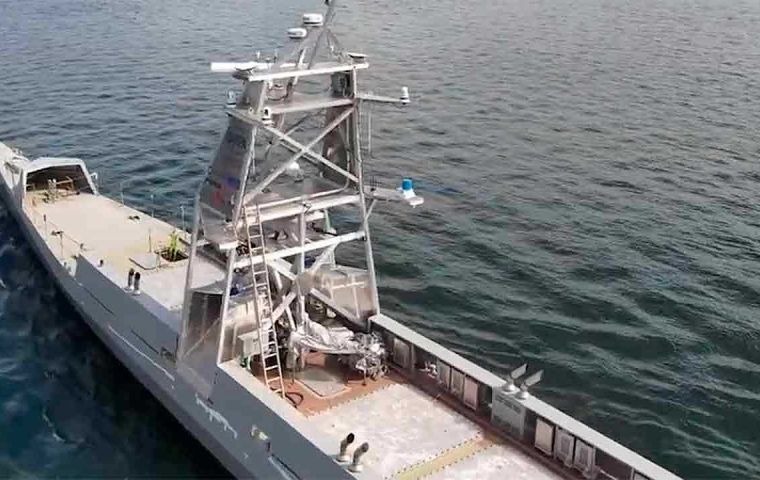MercoPress. South Atlantic News Agency
US Navy's and Royal Navy begin trials with un-crewed vessels
 Seen from above, the narrow width of the USX-1 Defiant is evident – thanks to the lack of human passageways (Picture: DARPA)
Seen from above, the narrow width of the USX-1 Defiant is evident – thanks to the lack of human passageways (Picture: DARPA) USX-1 Defiant is a prototype of the US program to develop autonomous vessels with no need for physical crews. She is the first US naval surface vessel ever built to operate without room or provisions for human crew.
Part of the No Manning Required Ship (NOMARS) program, it marks a new chapter in maritime innovation. It's a first-in-class – and according to DARPA, the US government's defense research body, it's the first of many.
At 55 meters long and 240 metric tons in weight, the vessel was constructed at Everett Ship Repair in the US state of Washington.
After being christened as per tradition by smashing a bottle on her hull, she's now undergoing extensive sea trials. After being christened as per tradition by smashing a bottle on her hull, she's now undergoing extensive sea trials.
These have included high-speed manoeuvres at almost 20 knots, automated harbor entries and dockings and refueling at sea. Water was used in place of fuel for safety.
During her first open-ocean voyage, the ship travelled more than 1,100 nautical miles to Port Hueneme, California, in five days.
By removing the need to accommodate humans, vessels can be more compact, cheaper, and quicker to build. One disadvantage, of course, is that if anything goes wrong, there are no humans on board to fix them, and a vessel could be hundreds of miles from shore.
Royal Navy and un-crewed boats off Scotland
Meanwhile off the coast of Scotland five un-crewed boats remotely-piloted from 500 miles away swarmed around HMS Tyne in a demonstration of how the Royal Navy could utilize such technology on operations. A real-life scenario of escorting a warship was played out during 72 hours of training off the coast of Scotland.
In a milestone for the navy’s Disruptive Capabilities and Technology Office, seven 7.2m autonomous Rattler boats have been trialed over the past few months with their latest test pushing the boats and their controllers to their limits.
On board XV Patrick Blackett, sitting alongside in HMNB Portsmouth, sailors, Royal Marines and Army personnel remotely-piloted five of the boats as they sailed in Scotland 500 miles away.
The demonstration saw the vessels work with P2000 HMS Biter of the Coastal Forces Squadron, a Merlin helicopter, HMS Tyne and HMS Stirling Castle in a proof of concept exercise.
With cameras, sensors and other data being fed back to Patrick Blackett, the Rattlers were able to successfully and safely escort Tyne and Stirling Castle who were playing the role of foreign warships.
The demonstration was a culmination of months of trials for DCTO and the Fleet Experimentation Squadron (FXS) while the project of procuring the boats saw the Royal Navy adopt a radical new approach with industry.
It’s the first time the Royal Navy has procured a fleet of customized un-crewed surface vessels, with the short turnaround time for delivery showing its intent going forward. (Forces.net)




Top Comments
Disclaimer & comment rulesCommenting for this story is now closed.
If you have a Facebook account, become a fan and comment on our Facebook Page!